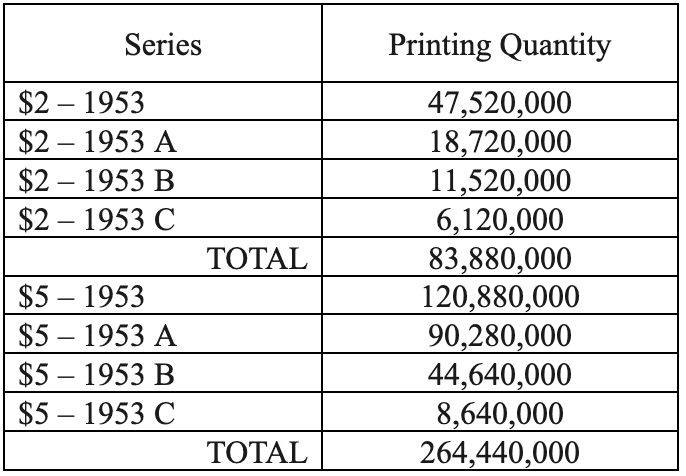
By CoinWeek Notes…
In 1953, the United States Bureau of Printing and Engraving (BEP) printed two denominations of United States Notes: $2 and $5. These notes are characterized by their distinctive red Treasury seals and serial numbers, earning them the nickname “Red Seal” notes. Unlike Federal Reserve Notes, which were issued by the Federal Reserve and had a green seal, United States Notes were a form of legal tender issued directly by the U.S. Treasury. This was the final series of United States Notes printed in the $5 denomination.
Both the $2 and $5 notes were issued in four series, with a series designation representing a change in the signatures of the U.S. Treasurer and the Secretary of the Treasury.
- Series 1953: Signed by U.S. Treasurer Ivy Baker Priest and Secretary of the Treasury George M. Humphrey.
- Series 1953-A: Signed by U.S. Treasurer Ivy Baker Priest and Secretary of the Treasury Robert B. Anderson.
- Series 1953-B: Signed by U.S. Treasurer Elizabeth Rudel Smith and Secretary of the Treasury C. Douglas Dillon.
- Series 1953-C: Signed by U.S. Treasurer Kathryn O’Hay Granahan and Secretary of the Treasury C. Douglas Dillon.
Each series was printed in batches of varying size, as can be seen in the chart below:

For collectors, a complete set of these notes also includes “star notes.” Star notes were created to replace misprinted or damaged bills that were removed before circulation. A small star symbol was placed to the left of the serial number to identify these replacement notes. Due to their nature, star notes were printed in much smaller quantities than regular notes, making them significantly scarcer and more valuable to collectors.

The star described above was first used by the BEP in 1935 to designate notes that were created to replace any misprinted or damaged pieces not released into circulation. Prior to this, the Bureau use a small asterisk. While it was moved on later notes to the right of each serial number, the star can be found to the left of the serial number on these early notes.
The last of these notes, the United States $2 and $5 bills, were actually delivered to the Federal Reserve as late as 1957 (Reed, 289).
The 1953 Notes in Today’s Market
While the majority of these notes are still affordable, their value is highly dependent on their condition and whether they are star notes.
$2 notes: In circulated condition, a standard $2 note is worth close to its face value. However, in pristine Uncirculated condition, values can range from $20 to over $40. Star notes carry a significant premium, with Uncirculated examples selling for $75 to over $150.
$5 notes: Similarly, circulated $5 bills are worth slightly more than face value, but Uncirculated examples can sell for over $50. Star notes are even more sought-after, with some Uncirculated examples valued at over $200.
The real difference in value for these notes comes not from the series designation, but from the presence of a star and the note’s overall condition.
Full, uncut sheets of these notes are quite rare. In 1997, there were only 26 sheets of the Series 1953 $2 known.
Description of the $2 and $5 Bills
The faces of both denominations share a similar design. In the center of the $2 note is a portrait of President Thomas Jefferson, while the $5 note features President Abraham Lincoln. Both notes prominently display the distinctive red Treasury seal and the legend “UNITED STATES NOTE” at the top. The red serial numbers are located at the upper left and upper right of the notes.
The legend “The United States of America Will Pay to the Bearer on Demand ___ Dollars” is also featured, although its placement differs slightly between the two denominations. On the $2 bill, this text is positioned beneath the portrait of Jefferson, while on the $5 bill, the phrase is split by the Lincoln portrait.
The reverse of the $2 note displays an image of Thomas Jefferson’s estate, Monticello. The reverse of the $5 bill features the Lincoln Memorial.
* * *
Sources
- Reed, 2007 – https://nnp.wustl.edu/library/book/533249?page=5
- https://www.money.org/collector/the-paiginator/blog/small-start-to-a-currency-collection
- https://nnp.wustl.edu/library/book/527461?page=24
The post Series 1953 United States $2 and $5 Notes : A Collector’s Guide appeared first on CoinWeek: Rare Coin, Currency, and Bullion News for Collectors.
VarietyErrors
Sign up for FREE News, Videos and Articles!

